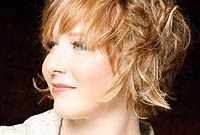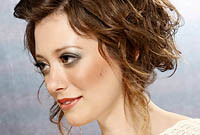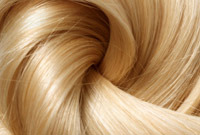Oily Hair
Interestingly there is no such thing as oily hair. It's in fact your scalp that produces the oil from a gland that's called the sebaceous gland. This gland manufactures a special natural oil (sebum), which is essential to the maintenance of a normal skin and hair condition.
- What To Do: You should consult with a qualified stylist for proper home hair care advice that includes the correct shampoo and conditioner.
Dry Hair
Your hair can be dry for a number of reasons. Blow-drying is the big one. Swimming is another; the sun and wind can dry your hair out also.
- What To Do: Use the right shampoo. Dry hair and scalp require a normal to dry hair shampoo, usually cream or lotion-like in appearance. As well a proper acid balanced conditioner is essential.
Chemically Dry Hair
Using any chemical in your hair has certain implications, one of them being a detrimental effect on your hair's condition. All chemical changes require expert attention at all times. Even a minute of neglect may cause great damage to the hair.
- What To Do: Your hair has no power of self-repair, so once it is damaged, you will have to wait for new hair growth to restore the hair to its normal function. Even if your hair is not chemically damaged, it will require special care and attention to help keep it in good condition.
Dandruff
Dandruff is a condition of the scalp where abnormal numbers of scales from the outer epidermis are constantly being shed. These thin, powdery scales lodge in the hair and fall out onto the shoulders. There are different types of dandruff, which are quite widespread.
Common: Dandruff may vary widely in appearance, but the most common type is that of a simple loss of dry, flat, epithelial scales. The scales are very difficult to remove by simple brushing or shampooing.
Oily Type: A more severe case is that of the oily type which has a patchy, crusting form. These scales are much larger and yellowish in color. If the crust is lifted from the scalp, the skin underneath is reddened and inflamed. This type of dandruff is found very often on the scalp of young babies and is known as cradle cap.
- What To Do: It is very important that any dandruff problem is seen early and treated by a qualified person to avoid a worsening of the condition.
Split Ends
At the ends or tips of the hair shaft the cuticle is often dislodged or broken away. The cortex is thus open to the drying effects of air, leading to frayed or split ends. There are many causes for the hair splitting, but all come down to one common cause. A lack of moisture in the hair shaft.
- What to do: The hair needs to be trimmed as quickly as possible.
Iritation
An irritated scalp is most likely the result of an allergic reaction. These symptoms can include tight sensitive scalp, itchy/sore scalp, some small white flaking (as a result of scratching), and in some cases, blistering of the skin. This is very different to dandruff disorders that are formed from things such as excessive cell production, gland disorders, and bacterial infection.
- What to do: The condition should be seen to as quickly as possible to avoid a worsening of the condition.
Alopecia
Refers to a condition of premature baldness or excessive hair loss. The natural falling out of hair should not be confused with Alopecia. When hair has grown to its full length, it comes out by itself and is replaced by a new hair. In the case of Alopecia, hair loss does not come back unless special treatments are given to encourage hair growth. The main reasons responsible for Alopecia includes, poor circulation, lack of proper stimulation, improper nourishment, certain infectious skin diseases such as ringworm, or constitutional disorders. Alopecia can also be caused due to a health disorder such as anemia or by some sort of direct injury to the nervous system. Since the flow of blood is influenced by the nervous system, the affected area is usually poorly nourished. There are different forms of Alopecia, the most common one being where the hair is falling out in round patches or spots. Theses areas of baldness can vary in size and shape from a few inches to 3 or 4 inches in diameter.
- What to do: The treatment for Alopecia is mostly directed in the stimulation of the blood supply, and in reviving the hair papilla or hair bulb. This is mostly done externally with injections into the scalp with cortisone or other chemical enhances.




